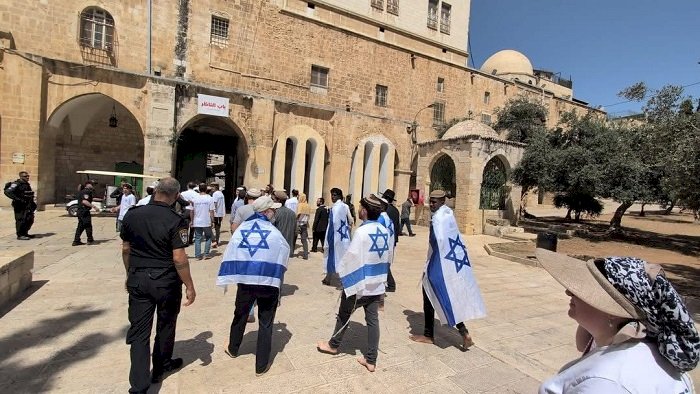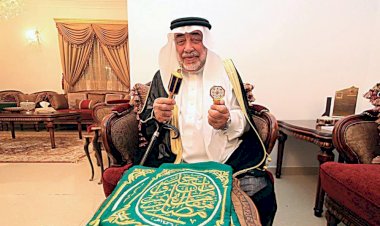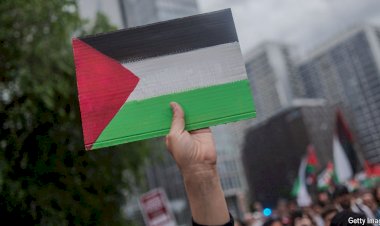Netanyahu Speaks Beneath Al-Aqsa as Settlers Storm Mosque Compound
Jerusalem – In a stark escalation of tensions in occupied East Jerusalem, Israeli Prime Minister Benjamin Netanyahu appeared in a video this week filmed from a tunnel running beneath the Al-Aqsa Mosque—coinciding with mass settler incursions and provocative religious rituals in the mosque compound. The series of events, widely condemned by Palestinians and observers alike, is being viewed as a coordinated attempt by the far-right Israeli government to impose new realities on one of Islam’s holiest sites.
Over the past 48 hours, Jerusalem has witnessed a dangerous convergence of political symbolism, religious extremism, and settler aggression. On Tuesday morning, under heavy police protection, dozens of Israeli settlers stormed the courtyards of Al-Aqsa in successive groups, openly performing Talmudic rituals and conducting what Palestinians described as “provocative tours.” These actions were not isolated incidents. According to the Palestinian news agency WAFA, Israeli police simultaneously turned the Old City into a heavily militarised zone, tightening restrictions on Palestinian worshippers, erecting checkpoints, and blocking access to many who sought to pray at the mosque.
But what has truly alarmed many is Netanyahu’s calculated appearance in a video filmed from a tunnel he claims stretches from Silwan—just south of Jerusalem—directly beneath Al-Aqsa. “Look at these stones,” he declared, standing beside ancient pavement. “These are the paving stones our ancestors walked on… There is no Zionism without Zion, and no Israel without Jerusalem.” The tunnel, part of the controversial "City of David" project, stretches from the Palestinian neighbourhood of Silwan to the area directly underneath the Al-Aqsa mosque.
The timing and location of Netanyahu’s statement carry much weight. Released on the day Israel marks its controversial “Jerusalem Day”—celebrating its occupation of East Jerusalem in the 1967 war—his words are seen as a direct challenge to the religious and historical significance of Al-Aqsa for Muslims worldwide. Analysts say the video signals two things: an official endorsement of the ongoing excavations beneath the mosque, which many fear threaten its structural integrity, and a deliberate use of religious narrative to entrench Israeli sovereignty claims over Jerusalem.
As Netanyahu’s message reverberated, thousands of Israeli settlers took to the streets in the annual “Flag March,” a highly contentious parade that snakes through Palestinian neighbourhoods in East Jerusalem, including the Muslim Quarter of the Old City and gates adjacent to Al-Aqsa. The march featured nationalist chants, anti-Arab slogans, and public religious performances. Among the participants was far-right National Security Minister Itamar Ben-Gvir, who himself stormed the Al-Aqsa compound earlier in the day, flanked by members of his Jewish Power party. “I came to the Temple Mount to pray for victory and full return,” he proclaimed in a video.
Such coordinated acts—settler incursions, nationalist parades, and political symbolism tied to a site of immense religious significance—are raising fears of a systematic plan to alter the status quo at Al-Aqsa. Palestinian and regional analysts argue that the events unfolding are not merely part of an Israeli religious festival, but a deliberate effort to expand Israeli control over the mosque and gradually erode Muslim sovereignty over the site. Many draw parallels to what happened at the Ibrahimi Mosque in Hebron, where Israeli authorities imposed spatial and temporal divisions after similar settler provocations.
What was once seen as a fringe movement—the so-called Temple Mount groups advocating for Jewish worship on the site—has now gained political legitimacy. With vocal support from cabinet ministers and members of the Knesset, these groups have transformed their agenda into state-backed incursions. Calls for wider “storming” of Al-Aqsa are growing, and the once-clear red lines appear to be fading.
Despite the gravity of the situation, the international response remains tepid. Global actors have issued generic statements of concern, yet no substantial diplomatic pressure or deterrent measures have been applied. Meanwhile, Palestinians on the ground continue to resist what they describe as a systematic assault on their religious and historical rights.
آلاف القطعان من المستوطنين يواصلون اقتحام ساحة حائط البراق في المسجد الأقصى بذكرى احتلال القدس الشرقية
— محمد علاء العناسوه (@alaa_tallaq) May 26, 2025
وهل ستحرك هذه المشاهدات والطقوس المستفزة والمقززة شيئاً ؟
صمت مطبق ليس له قولا إلا الشجب والإدانة والاستنكار pic.twitter.com/N0Vb88IcGi
Shaykh ʿIkrimah Ṣabrī, Imam and Khaṭīb of Al-Aqsa Mosque, told Al Jazeera that the occupation has imposed a siege on Jerusalem and is preventing Muslims from entering Al-Aqsa, while settlers are allowed to do whatever they please in the mosque’s courtyards.
He expressed regret over the lack of responses proportionate to the dangers and challenges currently facing Al-Aqsa.
The Fatah movement and other Palestinian factions have issued urgent calls for mass mobilisation and confrontation against these provocations. They warn that any tampering with Al-Aqsa could ignite unrest not just in Jerusalem, but across the region. In the words of one local resident near Bab al-Asbat:
“Al-Aqsa is not just a mosque—it’s our soul, our history. If they think we’ll watch silently, they are mistaken.”
Disclaimer
The views expressed in this article are the author’s own and do not necessarily mirror Islamonweb’s editorial stance.
























Leave A Comment